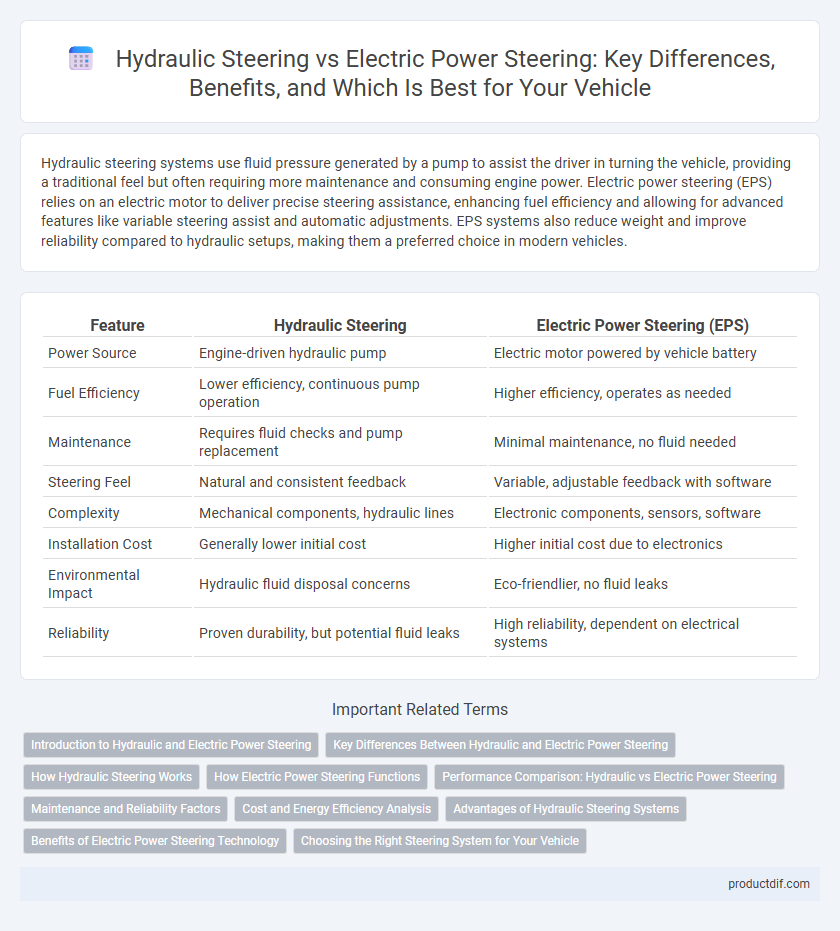Hydraulic steering systems use fluid pressure generated by a pump to assist the driver in turning the vehicle, providing a traditional feel but often requiring more maintenance and consuming engine power. Electric power steering (EPS) relies on an electric motor to deliver precise steering assistance, enhancing fuel efficiency and allowing for advanced features like variable steering assist and automatic adjustments. EPS systems also reduce weight and improve reliability compared to hydraulic setups, making them a preferred choice in modern vehicles.
Table of Comparison
| Feature | Hydraulic Steering | Electric Power Steering (EPS) |
|---|---|---|
| Power Source | Engine-driven hydraulic pump | Electric motor powered by vehicle battery |
| Fuel Efficiency | Lower efficiency, continuous pump operation | Higher efficiency, operates as needed |
| Maintenance | Requires fluid checks and pump replacement | Minimal maintenance, no fluid needed |
| Steering Feel | Natural and consistent feedback | Variable, adjustable feedback with software |
| Complexity | Mechanical components, hydraulic lines | Electronic components, sensors, software |
| Installation Cost | Generally lower initial cost | Higher initial cost due to electronics |
| Environmental Impact | Hydraulic fluid disposal concerns | Eco-friendlier, no fluid leaks |
| Reliability | Proven durability, but potential fluid leaks | High reliability, dependent on electrical systems |
Introduction to Hydraulic and Electric Power Steering
Hydraulic steering systems use pressurized fluid powered by the engine to assist driver input, providing reliable feedback and strong steering force in heavier vehicles. Electric power steering (EPS) replaces hydraulic pumps with an electric motor controlled by sensors and microprocessors, improving fuel efficiency and enabling advanced driver-assistance features. Both systems enhance vehicle control, but EPS offers more precise adjustments and reduced maintenance compared to traditional hydraulic setups.
Key Differences Between Hydraulic and Electric Power Steering
Hydraulic steering systems rely on engine-driven pumps to provide fluid pressure, offering strong, consistent feedback but consuming more energy and requiring regular maintenance. Electric power steering (EPS) uses electric motors controlled by sensors to assist steering, improving fuel efficiency and allowing variable assistance based on speed. Key differences include hydraulic systems' mechanical complexity and higher energy consumption versus EPS's precision control, reduced weight, and integration with advanced driver-assistance systems (ADAS).
How Hydraulic Steering Works
Hydraulic steering operates by using a pump driven by the engine to pressurize hydraulic fluid, which assists in turning the vehicle's wheels with less effort from the driver. The system includes a hydraulic cylinder connected to the steering mechanism that receives fluid pressure to amplify steering input. This technology relies on continuous flow of hydraulic fluid, providing consistent steering assistance but often consuming more power compared to electric power steering systems.
How Electric Power Steering Functions
Electric Power Steering (EPS) uses an electric motor to assist the driver's steering effort by amplifying the torque applied on the steering wheel, reducing physical strain and improving fuel efficiency compared to hydraulic systems. Sensors detect steering input and vehicle speed, adjusting the motor's assistance dynamically to ensure precise control and responsiveness. Unlike hydraulic steering, EPS eliminates the need for a power steering pump and fluid, lowering maintenance requirements and enabling easier integration with advanced driver-assistance systems (ADAS).
Performance Comparison: Hydraulic vs Electric Power Steering
Hydraulic steering offers strong, consistent feedback and durability in heavy-duty vehicles, relying on fluid pressure to assist steering, which can result in higher fuel consumption compared to electric power steering (EPS). EPS provides variable assistance driven by an electric motor, enhancing fuel efficiency and offering customizable steering feel through advanced sensors and control units. Performance-wise, EPS excels in precision and adaptability for modern vehicles, while hydraulic steering remains favored in applications demanding robust torque and reliability under extreme conditions.
Maintenance and Reliability Factors
Hydraulic steering systems require regular maintenance such as checking fluid levels, hoses, and pumps for leaks or wear, which can increase long-term costs and downtime. Electric power steering (EPS) systems offer improved reliability with fewer mechanical components and no hydraulic fluid, reducing the risk of leaks and minimizing maintenance requirements. However, EPS depends heavily on electronic sensors and control modules, which may require specialized diagnostic tools for repairs and can be costly if electronic failures occur.
Cost and Energy Efficiency Analysis
Hydraulic steering systems typically incur higher maintenance costs due to complex components like pumps and hoses, whereas electric power steering (EPS) requires less upkeep and offers lower operational expenses. In terms of energy efficiency, EPS significantly reduces fuel consumption by drawing power only when steering input is detected, unlike hydraulic systems that run continuously off engine power. The shift towards EPS aligns with industry trends prioritizing cost-effective and energy-conserving vehicle technologies.
Advantages of Hydraulic Steering Systems
Hydraulic steering systems provide robust and responsive feedback, enhancing driver control and road feel, especially at high speeds or during heavy-duty applications. They offer superior durability and consistent performance under extreme conditions, making them ideal for off-road vehicles and trucks. Maintenance and repair are typically simpler, with established technology that supports quick diagnostics and cost-effective parts replacement.
Benefits of Electric Power Steering Technology
Electric Power Steering (EPS) enhances fuel efficiency by reducing engine load compared to hydraulic systems, leading to lower emissions and operational costs. EPS offers improved steering precision and adaptability, enabling customizable steering feedback and integration with advanced driver-assistance systems (ADAS). Maintenance requirements are minimized since EPS eliminates hydraulic fluid, pumps, and belts, resulting in higher reliability and decreased downtime.
Choosing the Right Steering System for Your Vehicle
Hydraulic steering systems offer robust performance and consistent feedback, ideal for heavy-duty vehicles and off-road applications, while electric power steering (EPS) provides enhanced fuel efficiency and customizable assistance suited for modern passenger cars. Selecting the right steering system depends on vehicle type, driving conditions, and maintenance preferences, with EPS favored for its lower energy consumption and integration with advanced driver-assistance systems (ADAS). Evaluating factors such as steering feel, responsiveness, and cost of ownership ensures optimal control and comfort tailored to specific vehicle requirements.
Hydraulic Steering vs Electric Power Steering Infographic

 productdif.com
productdif.com